Global Trace Detection Screening Market Size
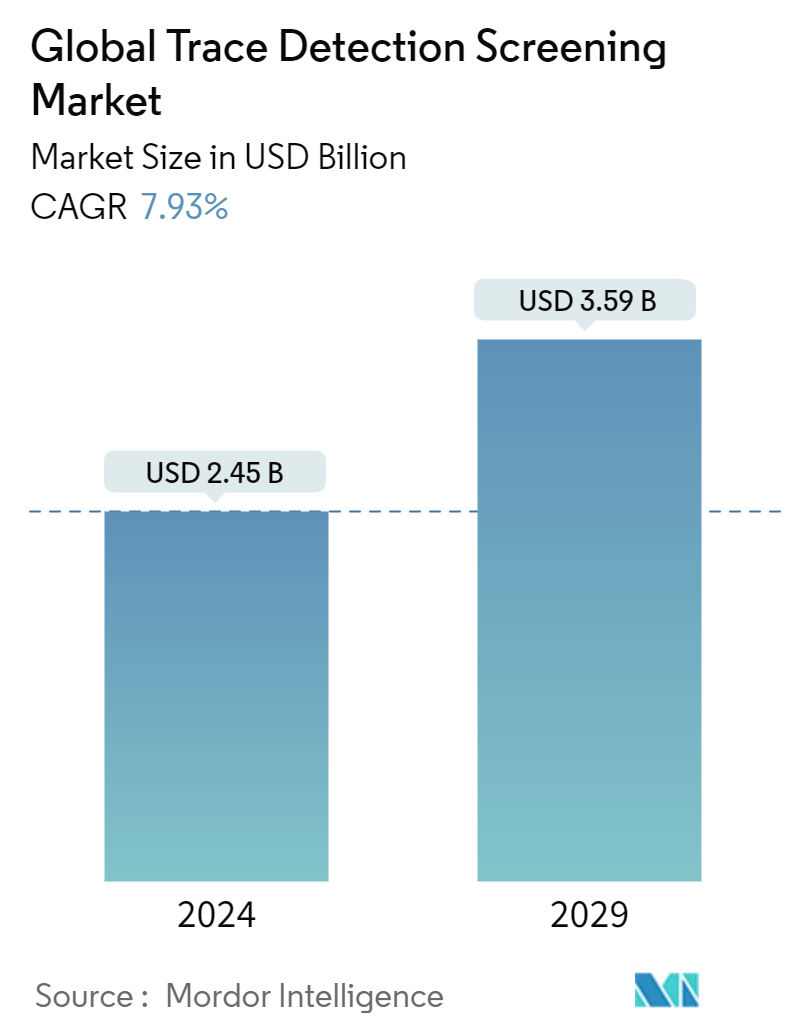
| Study Period | 2022 - 2029 |
| Market Size (2024) | USD 2.45 Billion |
| Market Size (2029) | USD 3.59 Billion |
| CAGR (2024 - 2029) | 7.93 % |
| Fastest Growing Market | Asia Pacific |
| Largest Market | North America |
Major Players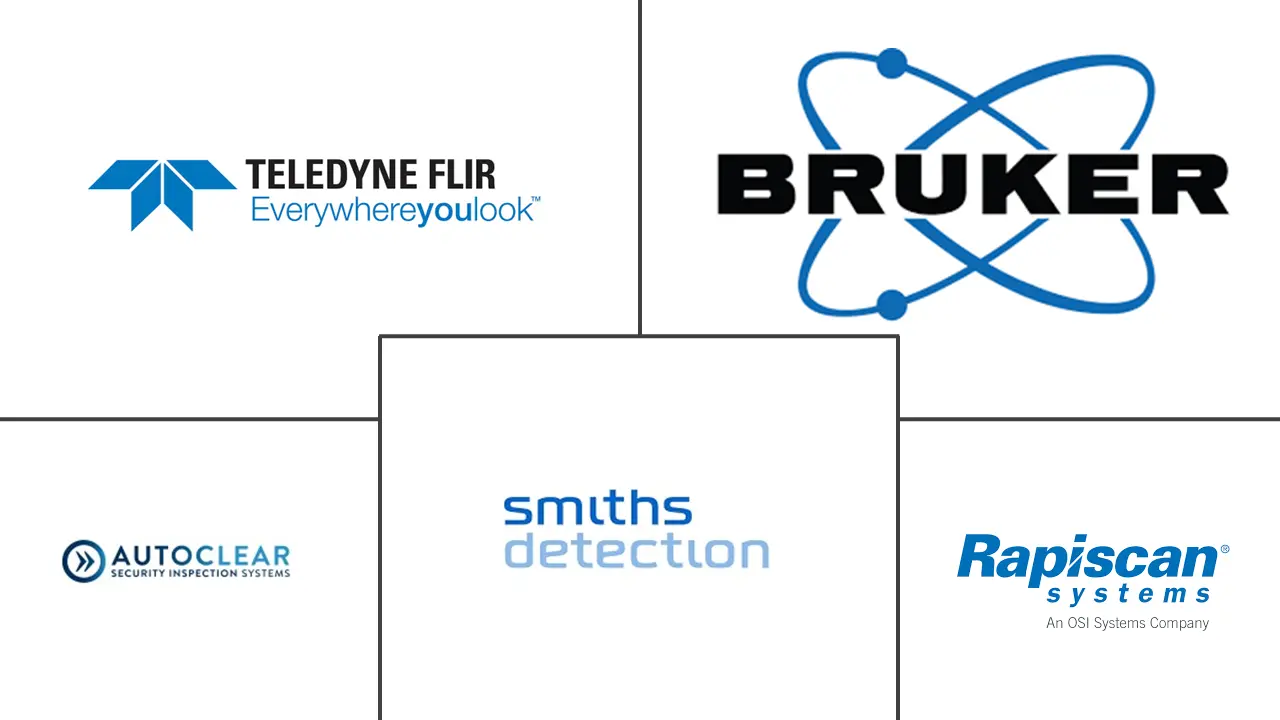
*Disclaimer: Major Players sorted in no particular order |
Global Trace Detection Screening Market Analysis
The Global Trace Detection Screening Market size is estimated at USD 2.45 billion in 2024, and is expected to reach USD 3.59 billion by 2029, growing at a CAGR of 7.93% during the forecast period (2024-2029).
- Several factors, like the growing demand for aviation security, strict regulations on public safety, rising terrorist attacks & security concerns, growth in defense expenditure, and the increasing awareness about the significance of security and benefits of trace detection systems, have led to their widespread adoption.
- Advancements in trace detection technology and efficiency will likely boost the market's growth. For instance, given the diverse nature of explosive dangers that airports confront, airports must be equipped with high-quality explosive detection capabilities to ensure their security. Explosive trace detectors can effectively detect explosives by employing their physical properties. Micro sensor-based explosive trace detectors can detect dangerous explosives like Ammonium Nitrate, RDX, and Nitro-glycerine.
- The devices utilize a simple and easy method of detection. The explosive molecules are pre-concentrated on a swab or swipe. The swab is inserted into the trace detection device. The emitted molecules are absorbed from the swab, the presence of explosives is detected, and the result is processed for reporting & confirming traces of explosives. Specific technologically enhanced ETDs can further classify the explosives into several categories and detect explosives with a sensitivity of 10 nanograms. High-speed electronics and advanced signal processing algorithms help the detection result.
- In the civil security sector, explosives have been detected mainly by stationary stand-alone devices, for instance, at airport security gates. The portable devices available on the market, weighing an average of five kilograms, are suitable only for a few mobile applications. Additionally, the maintenance and cleaning of these devices are very cost-intensive. To tackle the issue, in May 2023, a team of founders from the Federal Institute for Materials Research and Testing announced that they are striving to develop a mobile explosives trace detectors market that detects explosives more reliably, making an essential contribution to security in the civil sector.
- Narcotics trace detection is gaining significant importance for various reasons. It plays a prominent role in enhancing security measures by enabling the detection and prevention of illicit drug trafficking. It helps identify and intercept narcotics at various entry points, such as airports, seaports, and border crossings, thereby mitigating the risks associated with drug smuggling. It also helps secure compliance with regulations and international agreements related to drug control. Governments and regulatory bodies often require stringent measures to prevent the trafficking of narcotics. Trace-detecting technology assists in meeting these regulatory requirements and maintaining compliance.
- Further, the market is witnessing several innovations and investments in R&D to advance trace detector technology. For instance, in July 2023, the Department of Homeland Security Science and Technology Directorate’s Next Generation Explosives Trace Detection project was announced to develop R&D solutions to provide transportation security officers and specialists across the homeland security enterprise with advanced explosives trace detection and identification capabilities.
- However, explosive trace detectors have varying sensitivity levels and may not detect trace amounts of explosives. Also, the sampling techniques can influence the detectors' effectiveness. Proper sampling and collection of trace samples are crucial for accurate results. Inadequate sampling may lead to false negatives or false positives. Moreover, failure to calibrate or maintain the equipment can affect its accuracy and reliability. These factors may restrain the growth of the market.
- Further, implementing and maintaining trace detection systems can be costly, especially for organizations with limited budgets. The high cost of acquiring and operating screening systems, conducting regular training, and employing skilled personnel can significantly restrain the market.
- Besides the direct impact on various market verticals, the global pandemic is anticipated to have a long-term effect. For instance, since the pandemic outbreak, economies of multiple countries, which feel significant, are still unable to recover as anticipated, bringing a shadow of economic recession, especially in North American and European regions. For instance, according to the International Monitory Fund (IMF) estimates, the real GDP growth of the United States is anticipated to remain in a slowdown phase till 2024 before regaining momentum again. Such trends may also slow down the market during the forecast period.
Global Trace Detection Screening Market Trends
The Law Enforcement Segment is Anticipated to Drive the Market Demand
- Trace detection plays a vital role in law enforcement by enabling the identification and detection of trace amounts of substances such as explosives, drugs, and other illicit materials. This technique involves using specialized equipment and methods to detect minute quantities of substances, even when concealed or disguised. Law enforcement agencies utilize trace detection technology to enhance security measures, expedite case adjudication, and ensure public safety.
- Law enforcement agencies also use handheld explosive trace detectors to quickly assess potential threats and ensure public safety. These detectors rely on specialized technology, such as ion mobility spectrometry (IMS) or mass spectrometry, to detect trace amounts of explosives. Explosive trace detection in law enforcement is crucial in preventing terrorism, investigating bomb threats, and enhancing security measures in public spaces such as government buildings and major events. It enables law enforcement officers to identify and respond to potential threats on time, ensuring the safety of individuals and communities.
- Moreover, in crime scene investigation, trace detection is employed to identify and collect trace evidence, such as fibers, hairs, or other microscopic particles that may link a suspect to a crime. Using trace detection technology, law enforcement agencies can gather valuable evidence that may be critical in solving criminal cases and ensuring justice.
- In the prison context, trace detection can be used for various purposes, such as detecting illicit drugs, weapons, or other contraband. The increasing prison population globally is anticipated to drive the growth of the market. For instance, according to ICPR (Institute for Crime & Justice Policy Research), at the end of 2023, the United States had the highest number of incarcerated individuals worldwide, with almost 1.8 million people in prison. China followed it with around 100,000 fewer prisoners.
- Further, according to the House of Commons, 83,128 men and 3,259 women were in prisons in England and Wales in 2023. Compared with the previous year, this represented an increase for both males and females.
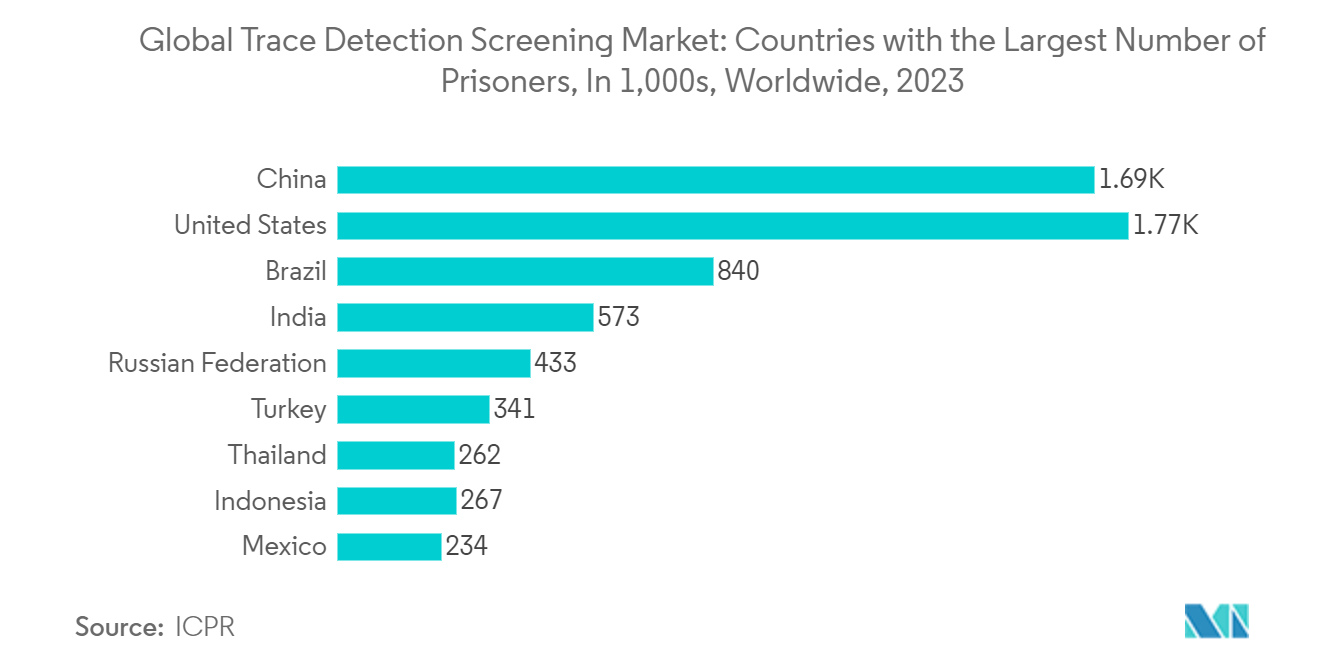
Asia Pacific is Anticipated to Register Robust Market Growth Rate
- Trace detection plays a crucial role in aviation security. It involves using specialized equipment and techniques to detect microscopic particles or traces of explosive materials on individuals, baggage, cargo, or other items that pass through airport checkpoints. By detecting these terraces, authorities can identify potential threats and take appropriate measures to ensure the safety of passengers and aviation infrastructure.
- Explosive trace detectors have become an essential component of the layered aviation security structure at several airports across India and the world. In February 2023, Smiths Detection, a global player in threat detection and security screening, announced that it signed an agreement to supply Noida International Airport with passenger and hold baggage screening equipment to ensure safety and efficiency for passengers and operators.
- Moreover, Smiths Detection would supply the HI-SCAN 6040 DV, an advanced high-resolution, dual-view X-ray screening system for screening passenger carry-on baggage; the IONSCAN 600, a portable explosives and narcotics trace detector; and multiple additional X-ray screening systems for screening oversized goods and other devices.
- In April 2024, MS Tech Ltd, a global developer, manufacturer, and innovator of nanotechnology, IoT, and big-data sensors, announced that MS Detection, its homeland security and defense division, completed another series of shipments and installations of its EXPLOSCAN, DUOSCAN, MULTISCAN, and THREATSCAN explosives and narcotics trace and vapor detection systems.
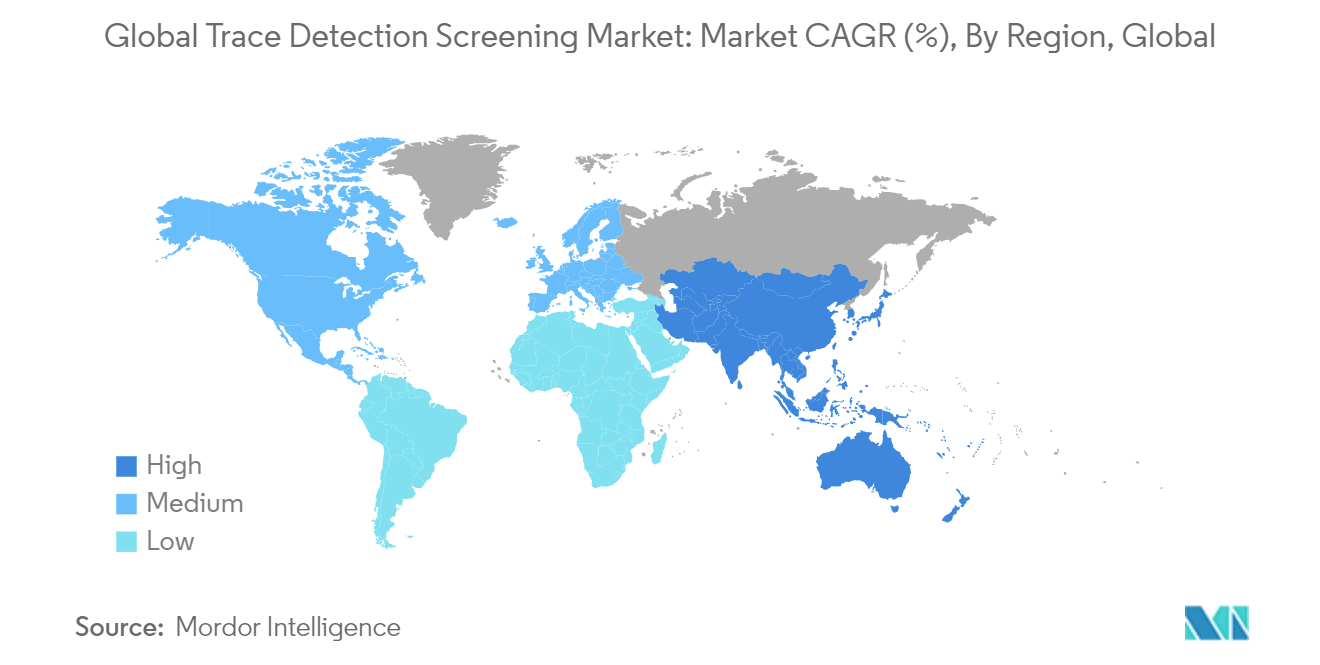
Global Trace Detection Screening Industry Overview
The global trace detection screening market is semi-consolidated, with significant players like Smiths Detection Group, Leidos, Teledyne Flir LLC, and Bruker Corporation. The market players are innovating advanced products and processes to cater to consumers' needs through extensive investments in R&D, product launches, collaborations, etc.
In September 2023, Fraport AG announced the procurement decision in favor of Bruker for providing up to 220 DE-tector flex explosives and narcotics trace detectors to help their airport security measures. The installations are planned over a multi-year period from 2023 to 2027 to modernize the screening of passengers at Germany’s busiest airport, FRA. The advanced, high-performance Bruker DE-tector flex systems are intended to replace earlier-generation Bruker ETD systems at Frankfurt airport. As per the company, traces of most explosives and many illegal drug substances can be accurately traced by wiping surfaces with multi-use, disposable swabs and inserting them into the DE-tector flex.
In August 2023, OSI Systems Inc. announced that its Rapiscan Itemiser 5X Explosive Trace Detection device met the TSA's qualification standards for inclusion on the Air Cargo Screening Technology List.
In August 2023, Smiths Detection, a global player in threat detection and security screening technology, announced that its IONSCAN 600 explosives trace detector was designated as Qualified Technology on the Transportation Security Administration’s Air Cargo Screening Technology List. This allows the IONSCAN 600 to be purchased and utilized as part of global screening operations by regulated air cargo facilities.
Global Trace Detection Screening Market Leaders
-
Smiths Detection Group Ltd
-
Teledyne Flir LLC
-
Bruker Corporation
-
Autoclear, LLC
-
Rapiscan Systems, Inc
*Disclaimer: Major Players sorted in no particular order
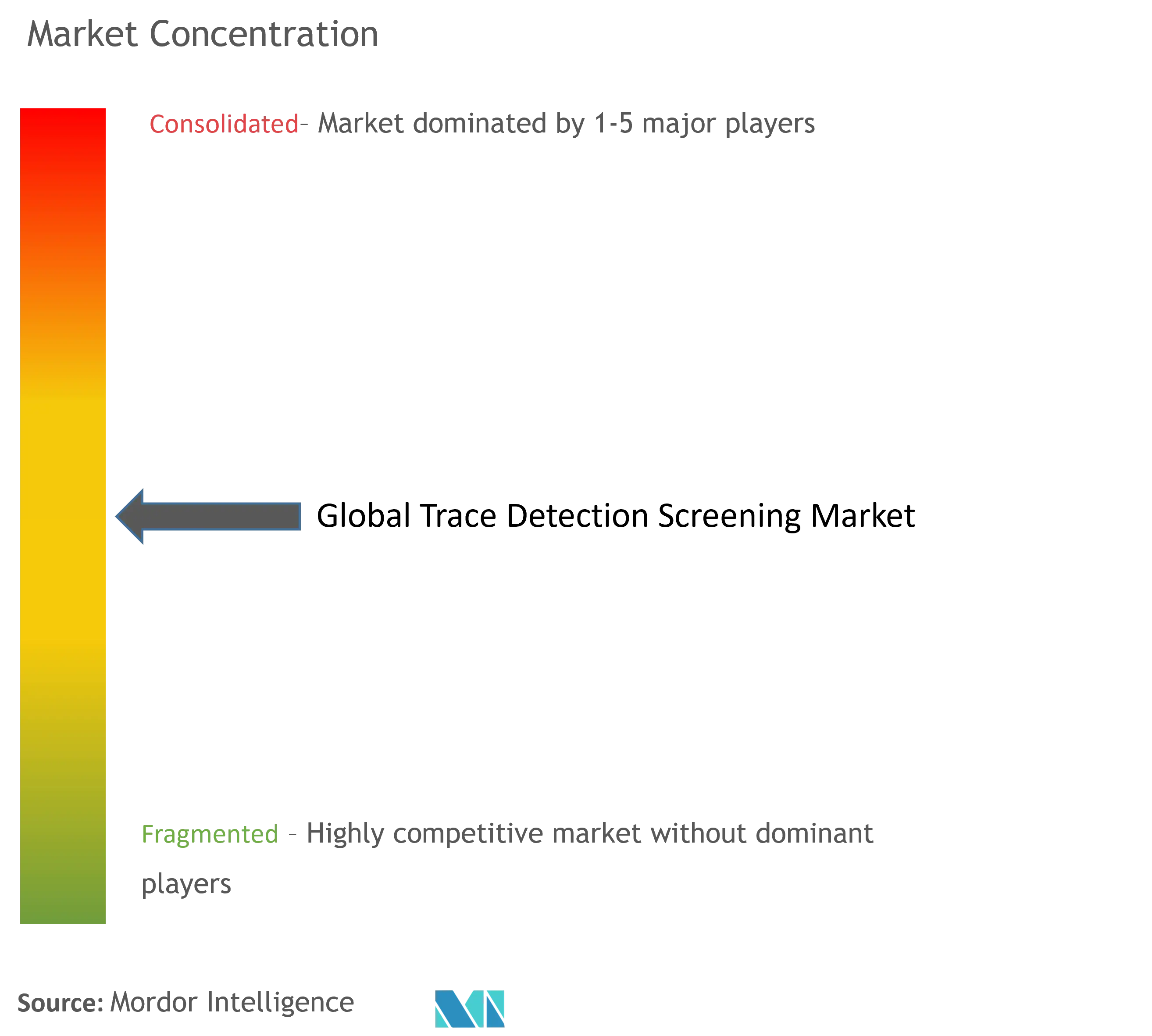
Global Trace Detection Screening Market News
- July 2024: Smiths Detection, a global firm in threat detection and security screening technologies, announced its partnership with Flughafen Zürich AG (Zurich Airport). This collaboration will trial the state-of-the-art HI-SCAN 6040 CTiX carry-on baggage X-ray scanners and the iLane A20SC ATRS, an advanced automatic tray return system, at two of the airport's security lanes.
- March 2024: OSI Systems, Inc. ("OSI Systems" or the "Company") announced that its Security division secured a contract valued at around USD27 million. The contract entails supplying Itemiser® 5X explosive trace detection (ETD) systems for secondary screening of passengers and their carry-on baggage at airport checkpoints. Additionally, the contract includes related consumables for a prominent European airport.
Global Trace Detection Screening Market Report - Table of Contents
1. INTRODUCTION
- 1.1 Study Assumptions and Market Definition
- 1.2 Scope of the Study
2. RESEARCH METHODOLOGY
3. EXECUTIVE SUMMARY
4. MARKET INSIGHTS
- 4.1 Market Overview
- 4.2 Technology Snapshot
- 4.3 Industry Value Chain Analysis
-
4.4 Industry Attractiveness - Porter's Five Forces Analysis
- 4.4.1 Threat of New Entrants
- 4.4.2 Bargaining Power of Consumers
- 4.4.3 Bargaining Power of Suppliers
- 4.4.4 Threat of Substitute Products
- 4.4.5 Intensity of Competitive Rivalry
- 4.5 Impact of COVID-19 Aftereffects and Other Macroeconomic Factors on the Market
5. MARKET DYNAMICS
-
5.1 Market Drivers
- 5.1.1 Upsurge in Terrorist Activities Across the Globe
- 5.1.2 Growing Government Investments in Security Infrastructure
- 5.1.3 Increasing Government Guidelines for Aviation Security Screening
-
5.2 Market Restraints
- 5.2.1 High Initial Cost of Installation and Subsequent Maintenance Costs
- 5.2.2 Technological Limitations and the Lack of Trained Personnel
6. MARKET SEGMENTATION
-
6.1 By Type
- 6.1.1 Explosive
- 6.1.2 Narcotics
-
6.2 By Product
- 6.2.1 Handheld
- 6.2.2 Portable/Movable
- 6.2.3 Fixed
-
6.3 By End-user Industry
- 6.3.1 Commercial
- 6.3.2 Military and Defense
- 6.3.3 Law Enforcement
- 6.3.4 Ports and Borders
- 6.3.5 Public Safety
- 6.3.6 Other End-user Industries
-
6.4 By Geography
- 6.4.1 North America
- 6.4.2 Europe
- 6.4.3 Asia
- 6.4.4 Australia and New Zealand
- 6.4.5 Middle East and Africa
- 6.4.6 Latin America
7. COMPETITIVE LANDSCAPE
-
7.1 Company Profiles*
- 7.1.1 Smiths Detection Group Ltd
- 7.1.2 Rapiscan Systems Inc.
- 7.1.3 Teledyne Flir LLC
- 7.1.4 Bruker Corporation
- 7.1.5 Autoclear LLC
- 7.1.6 DetectaChem
- 7.1.7 Mass Spec Analytical Ltd
- 7.1.8 High Tech Detection Systems (HTDS)
- 7.1.9 DSA Detection LLC
- 7.1.10 Vehant Technologies Pvt. Ltd
- 7.1.11 Leidos Holdings Inc.
- 7.1.12 Westminster Group PLC
- 7.1.13 Biosensor Applications AB
8. INVESTMENT ANALYSIS
9. FUTURE OF THE MARKET
** Subject To AvailablityGlobal Trace Detection Screening Industry Segmentation
Trace detection is the detection or identification of minute or trace amounts of a substance or material. It involves collecting samples from surfaces, objects, or the environment and analyzing them, using specialized equipment or methods to detect the target substance at very low concentrations.
The global trace detection screening market is segmented by type (explosives and narcotics), product (handheld, portable/movable, and fixed), End Use (Commercial, Military and Defense, Law Enforcement, Ports and Borders, and Public Safety), and Geography (North America, Asia Pacific, Europe, Middle East and Africa, and Latin America). The market sizes and forecasts are provided in terms of value (USD) for all the above segments.
| By Type | Explosive |
| Narcotics | |
| By Product | Handheld |
| Portable/Movable | |
| Fixed | |
| By End-user Industry | Commercial |
| Military and Defense | |
| Law Enforcement | |
| Ports and Borders | |
| Public Safety | |
| Other End-user Industries | |
| By Geography | North America |
| Europe | |
| Asia | |
| Australia and New Zealand | |
| Middle East and Africa | |
| Latin America |
Global Trace Detection Screening Market Research FAQs
How big is the Global Trace Detection Screening Market?
The Global Trace Detection Screening Market size is expected to reach USD 2.45 billion in 2024 and grow at a CAGR of 7.93% to reach USD 3.59 billion by 2029.
What is the current Global Trace Detection Screening Market size?
In 2024, the Global Trace Detection Screening Market size is expected to reach USD 2.45 billion.
Who are the key players in Global Trace Detection Screening Market?
Smiths Detection Group Ltd, Teledyne Flir LLC, Bruker Corporation, Autoclear, LLC and Rapiscan Systems, Inc are the major companies operating in the Global Trace Detection Screening Market.
Which is the fastest growing region in Global Trace Detection Screening Market?
Asia Pacific is estimated to grow at the highest CAGR over the forecast period (2024-2029).
Which region has the biggest share in Global Trace Detection Screening Market?
In 2024, the North America accounts for the largest market share in Global Trace Detection Screening Market.
What years does this Global Trace Detection Screening Market cover, and what was the market size in 2023?
In 2023, the Global Trace Detection Screening Market size was estimated at USD 2.26 billion. The report covers the Global Trace Detection Screening Market historical market size for years: 2022 and 2023. The report also forecasts the Global Trace Detection Screening Market size for years: 2024, 2025, 2026, 2027, 2028 and 2029.
Global Trace Detection Screening Industry Report
Statistics for the 2024 Global Trace Detection Screening market share, size and revenue growth rate, created by Mordor Intelligence™ Industry Reports. Global Trace Detection Screening analysis includes a market forecast outlook for 2024 to 2029 and historical overview. Get a sample of this industry analysis as a free report PDF download.



